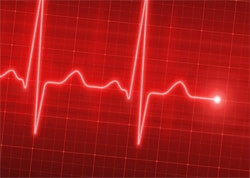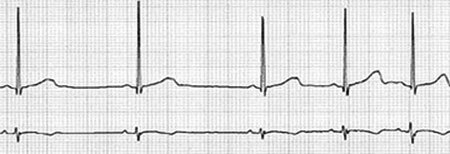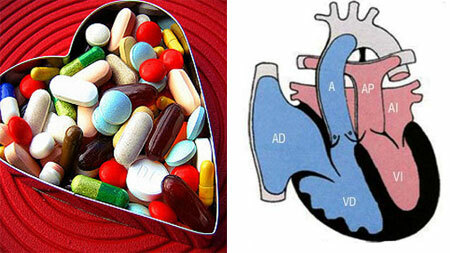Both an adult and a child may experience sinus arrhythmia. Such a violation of the heart rhythm occurs in different people and only in half of cases it is a pathology. We will analyze what this problem is and who it usually comes up with.
Contents of
- 1 Sinus arrhythmia of the heart - what is it?
- 2 Sinus arrhythmia in children
- 3 Signs and types of sinus arrhythmia
- 4 Diagnosis
- 5 About sinus arrhythmia treatment
Sinus arrhythmia of the heart - what is it?
 Sinus arrhythmia of the heart is such an irregular sinus rhythm, which is characterized by a changing heart rate.
Sinus arrhythmia of the heart is such an irregular sinus rhythm, which is characterized by a changing heart rate.
Sinus rhythm is the frequency of heartbeats imposed by the driver of the rhythm( sinus node) with equal intervals between them. If the coordination in the work of the heart remains, but the intervals between its contractions differ from each other, then it is a question of sinus arrhythmia.
To a certain extent, this condition can occur in any healthy person, because the heart can not constantly contract with equal frequency: sometimes the rhythm accelerates, sometimes it slows down. Minimal changes in frequency are usually associated with the process of breathing.
If severe sinus arrhythmia is not associated with an act of breathing, this may indicate a malfunction in the vegetative system or a cardiovascular system.
Diseases and conditions of , which are accompanied by this pathology:
- hormonal imbalance( menopause, pregnancy, endocrine disorders);
- diseases of the musculoskeletal system, in particular the spine( hernia, osteochondrosis, etc.);
- stresses and emotional overload;
- liver disease;
- exposure to low temperatures;
- , vegetative-vascular dystonia, etc.
The causes of sinus arrhythmia can be varied, but in most cases this pathology does not cause serious problems for the patient.
Sinus arrhythmia in children
Parents, after performing an ECG in a child, can often see this diagnosis in the conclusion line. Usually adult people are frightened by any incomprehensible concept, and they begin to pester the doctor with the question: what is a sinus arrhythmia of the heart and how dangerous it is for a child.
The heart of a child can contract at different frequencies depending on the age. Thus, the frequency of cardiac contractions in the range of 120-140 beats per minute is considered normal in infants of the first days of life. Every year it decreases and at the age of 13-15 years it becomes equal to the norm of an adult person( 60-90 beats per minute).
This type of rhythm disturbance in a child is absolutely normal and in most cases is associated with respiratory processes.
Sinus arrhythmia in children is due to the fact that at the time of inspiration heart rate reflex increases, and on expiration slows down. In addition, the heart rate itself can be affected by the process of setting the ECG sensors to the child and at the beginning of the heart rate procedure increases dramatically, and as the baby calms down, the rhythm slows down.
This is due to the immaturity of the nervous system of the baby and the imperfection of the regulation of vascular tone. As the child grows and develops, episodes of such sinus arrhythmia are less common, and it disappears by itself.
Other causes of this pathology in children not associated with respiration:
- Genetic predisposition. If someone in the family suffers from a similar problem, then it can be passed on to the child.
- Congenital or acquired( rheumatic) heart defects.
- Infectious diseases, accompanied by severe intoxication of the body. These diseases, as a rule, are accompanied by vomiting, diarrhea, increased sweating and lead to dehydration. The baby quickly changes the water and salt balance, and malfunctions in the heart begin.
- Vegeto-vascular dystonia. The disease associated with the imperfection of the regulation of the vascular tone: they then expand, then narrow, which leads to a number of characteristic symptoms.
- Inflammation and heart tumor. They are rare.
Important! Sinus arrhythmia is not a contraindication for sports. In these cases, the child is simply observed more often and every few months, ECG and other studies are performed.
Signs and types of sinus arrhythmia

Sinus arrhythmia is often not accompanied by unpleasant sensations, since it does not significantly affect hemodynamics( movement of blood through the vessels).If this kind of arrhythmia is combined with another cardiac pathology, then the patient begins to worry about pain in the heart and other symptoms.
There are several types of sinus arrhythmia, depending on the heart rate:
1. Tachyarrhythmia. Accompanied by rapid heart rate above 85-90 beats per minute. With physical activity, stress, trauma, this condition is regarded as a variant of the norm. If it occurs in a state of rest, then it can speak about the presence of heart diseases, endocrine organs or vegeto-vascular dystonia.
2. Bradyarrhythmia. Heart rate significantly slows down( below 60 beats / min).With this form of the patient, uncomfortable symptoms in the form of dizziness, weakness, tinnitus are disturbed. He can faint.
3. Extrasystole - an extraordinary reduction of the heart. Maybe one-time, in these cases, do not pay attention to it. When detecting permanent extrasystoles, complex diagnostics is performed and the treatment is selected.
Diagnosis

ECG with sinus arrhythmia, photo
The key diagnostic method is the ECG in combination with Holter monitoring. With this method of diagnosis, a portable ECG device is attached to the patient for a day, which constantly records changes in the heart.
In parallel, the patient keeps a diary, which records all events occurring in the day and their reactions to them.
This type of arrhythmia looks like a normal sinus rhythm on the ECG with a difference in the P-P or R-R intervals. The remaining indicators remain within normal limits. Of secondary importance is the occurrence of arrhythmia with deep breathing, and its disappearance after a delay in breathing.
- See how to decode the ECG and what they mean.
About the treatment of sinus arrhythmia
If the difference between cardiac fluctuations is 10% or less, then this rhythm disturbance is considered physiological and does not require special treatment.
To eliminate possible symptoms, the patient is selected diet, moderate exercise and learn to avoid stress. In the menu I include products rich in potassium and magnesium.
- If the sinus arrhythmia is caused by another disease, then the medication is aimed at eliminating the underlying problem.
Sinus arrhythmia is one of the favorable rhythm disturbances, which can be both normal and pathological. Special therapy with this form of arrhythmia is usually not required.



